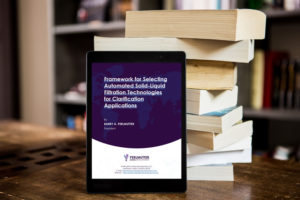
Over my almost 40 years in the process industry, many people have helped me along the way. Having opened my own consulting business, Perlmutter & Idea Development, I thought it time to give back to the engineering and process communities. Earlier this year I taught a short course in the American Filtration Separations Society Learning Center, “Automatic Filtration Technologies.” This month, I have released a related e-book, Framework for Selecting Automated Solid-Liquid Filtration Technologies for Clarification Applications.
This e-book is the first-of-its-kind specifically for the process industries. Based on my experiences, and my collaborations with other process experts, this book provides in-depth treatment of possibilities to automate the clarification processes to improve filtration while minimizing operator exposure.
Understanding Clarification Systems
A clarification system is employed after coarse-particle filtration or as a stand-alone system to remove fine particles at low concentrations. These particles are typically less than five microns (μm) and are in concentrations less than five percent solids down to ppm levels. Engineers can evaluate several types of automated, pressure-filtration, clarification technologies. The cake solids structure and the nature of the process determine which type of clarification system is appropriate for an application.
Framework for Selecting Automated Solid-Liquid Filtration Technologies for Clarification Applications:
- Characterizes slurries
- Discusses filtration lab testing
- Differentiates between candle filters, circular plate filters, concentrating candle filters
- Explores filter media and filter aid options
- Shares case studies from the specialty chemical industry (resins, zeolites and pharmaceutical)
Practical Applications of Automatic Filtration Technology
I’ve encountered some interesting approaches to solid-liquid separation processes. In one case, I was at a melamine resin facility where the slurry was in a formaldehyde process. The operators were wearing “masks” opening up a manual plate filter in a room with residential floor fans to dig out the cake from the paper filter media. In another case, for zeolites, the client had multiple bag filters to clarify the filtrates following a vacuum belt filter. When the final product remained cloudy,
to my surprise, the client decided to add another set of bag filters.
You probably have your own examples of process engineers struggling to clarify process liquids. The Framework for Selecting Automated Solid-Liquid Filtration Technologies for Clarification Applications presents actual case histories to illustrate problems and improved installations with automatic filtration.
If you want to learn more about automatic filtration technology alternatives to manual plate filters, bag filters, and filter presses, I encourage you to download my new ebook today!

